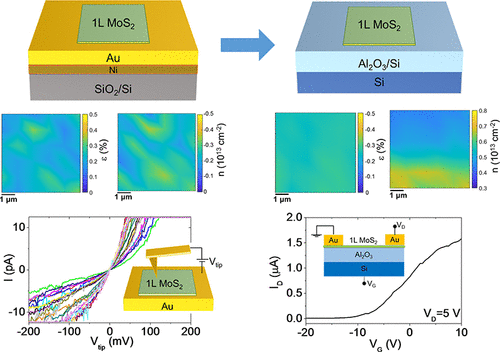当前位置:
X-MOL 学术
›
ACS Appl. Mater. Interfaces
›
论文详情
Our official English website, www.x-mol.net, welcomes your
feedback! (Note: you will need to create a separate account there.)
Strain, Doping, and Electronic Transport of Large Area Monolayer MoS2 Exfoliated on Gold and Transferred to an Insulating Substrate
ACS Applied Materials & Interfaces ( IF 8.3 ) Pub Date : 2021-06-24 , DOI: 10.1021/acsami.1c05185 Salvatore Ethan Panasci 1, 2 , Emanuela Schilirò 1 , Giuseppe Greco 1 , Marco Cannas 3 , Franco M Gelardi 3 , Simonpietro Agnello 1, 3, 4 , Fabrizio Roccaforte 1 , Filippo Giannazzo 1
ACS Applied Materials & Interfaces ( IF 8.3 ) Pub Date : 2021-06-24 , DOI: 10.1021/acsami.1c05185 Salvatore Ethan Panasci 1, 2 , Emanuela Schilirò 1 , Giuseppe Greco 1 , Marco Cannas 3 , Franco M Gelardi 3 , Simonpietro Agnello 1, 3, 4 , Fabrizio Roccaforte 1 , Filippo Giannazzo 1
Affiliation

|
Gold-assisted mechanical exfoliation currently represents a promising method to separate ultralarge (centimeter scale) transition metal dichalcogenide (TMD) monolayers (1L) with excellent electronic and optical properties from the parent van der Waals (vdW) crystals. The strong interaction between Au and chalcogen atoms is key to achieving this nearly perfect 1L exfoliation yield. On the other hand, it may significantly affect the doping and strain of 1L TMDs in contact with Au. In this paper, we systematically investigated the morphology, strain, doping, and electrical properties of large area 1L MoS2 exfoliated on ultraflat Au films (0.16–0.21 nm roughness) and finally transferred to an insulating Al2O3 substrate. Raman mapping and correlative analysis of the E′ and A1′ peak positions revealed a moderate tensile strain (ε ≈ 0.2%) and p-type doping (n ≈ −0.25 × 1013 cm–2) of 1L MoS2 in contact with Au. Nanoscale resolution current mapping and current–voltage (I–V) measurements by conductive atomic force microscopy (C-AFM) showed direct tunneling across the 1L MoS2 on Au, with a broad distribution of tunneling barrier values (ΦB from 0.7 to 1.7 eV) consistent with p-type doping of MoS2. After the final transfer of 1L MoS2 on Al2O3/Si, the strain was converted to compressive strain (ε ≈ −0.25%). Furthermore, an n-type doping (n ≈ 0.5 × 1013 cm–2) was deduced by Raman mapping and confirmed by electrical measurements of an Al2O3/Si back-gated 1L MoS2 transistor. These results provide a deeper understanding of the Au-assisted exfoliation mechanism and can contribute to its widespread application for the realization of novel devices and artificial vdW heterostructures.
中文翻译:

在金上剥离并转移到绝缘基板上的大面积单层 MoS2 的应变、掺杂和电子传输
金辅助机械剥离目前是一种很有前途的方法,可以从母体范德华 (vdW) 晶体中分离出具有优异电子和光学性能的超大 (厘米级) 过渡金属二硫属化物 (TMD) 单层 (1L)。Au 和硫属元素原子之间的强相互作用是实现这一近乎完美的 1L 剥离产量的关键。另一方面,它可能会显着影响与 Au 接触的 1L TMDs 的掺杂和应变。在本文中,我们系统地研究了在超平坦 Au 薄膜(0.16-0.21 nm 粗糙度)上剥离并最终转移到绝缘 Al 2 O 3上的大面积 1L MoS 2的形貌、应变、掺杂和电性能基质。E' 和 A 1 '峰位置的拉曼映射和相关分析表明,1L MoS 2与金。通过导电原子力显微镜 (C-AFM) 进行的纳米级分辨率电流映射和电流-电压 ( I – V ) 测量显示直接隧穿穿过 Au 上的 1L MoS 2,具有广泛的隧穿势垒值分布(Φ B从 0.7 到 1.7 eV)与MoS 2的p型掺杂一致。在Al 2 O上最终转移 1L MoS 2后3 /Si,应变转换为压缩应变(ε≈-0.25%)。此外,通过拉曼映射推断出 n 型掺杂 ( n ≈ 0.5 × 10 13 cm –2 ),并通过 Al 2 O 3 /Si 背栅 1L MoS 2晶体管的电学测量得到证实。这些结果提供了对金辅助剥离机制的更深入理解,并有助于其在实现新型器件和人造 vdW 异质结构方面的广泛应用。
更新日期:2021-07-07
中文翻译:

在金上剥离并转移到绝缘基板上的大面积单层 MoS2 的应变、掺杂和电子传输
金辅助机械剥离目前是一种很有前途的方法,可以从母体范德华 (vdW) 晶体中分离出具有优异电子和光学性能的超大 (厘米级) 过渡金属二硫属化物 (TMD) 单层 (1L)。Au 和硫属元素原子之间的强相互作用是实现这一近乎完美的 1L 剥离产量的关键。另一方面,它可能会显着影响与 Au 接触的 1L TMDs 的掺杂和应变。在本文中,我们系统地研究了在超平坦 Au 薄膜(0.16-0.21 nm 粗糙度)上剥离并最终转移到绝缘 Al 2 O 3上的大面积 1L MoS 2的形貌、应变、掺杂和电性能基质。E' 和 A 1 '峰位置的拉曼映射和相关分析表明,1L MoS 2与金。通过导电原子力显微镜 (C-AFM) 进行的纳米级分辨率电流映射和电流-电压 ( I – V ) 测量显示直接隧穿穿过 Au 上的 1L MoS 2,具有广泛的隧穿势垒值分布(Φ B从 0.7 到 1.7 eV)与MoS 2的p型掺杂一致。在Al 2 O上最终转移 1L MoS 2后3 /Si,应变转换为压缩应变(ε≈-0.25%)。此外,通过拉曼映射推断出 n 型掺杂 ( n ≈ 0.5 × 10 13 cm –2 ),并通过 Al 2 O 3 /Si 背栅 1L MoS 2晶体管的电学测量得到证实。这些结果提供了对金辅助剥离机制的更深入理解,并有助于其在实现新型器件和人造 vdW 异质结构方面的广泛应用。

































 京公网安备 11010802027423号
京公网安备 11010802027423号